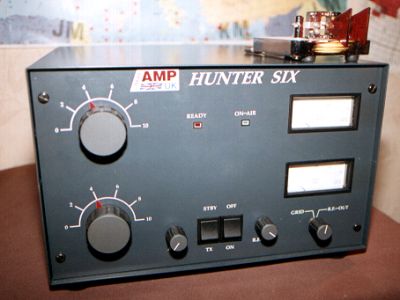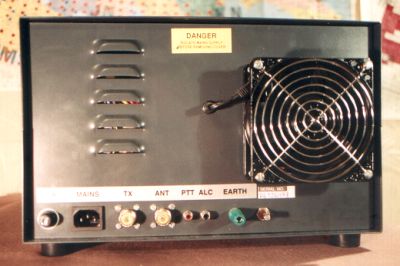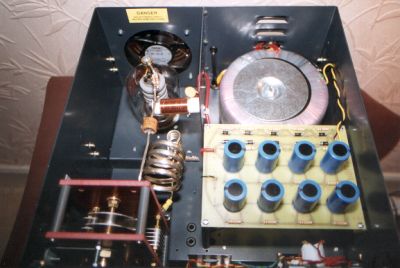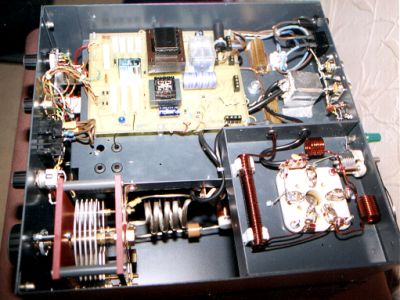
They say that all good things come in small packages, but don’t you believe it. The Hunter Six linear amplifier manufactured in Yorkshire, England by Linear Amp UK lives up to that county’s reputation for producing tough heavyweight street-fighters.
This amplifier has been designed around a simple premise: crunching the pile-ups and
getting noticed in the noisiest of band conditions. If you are interested in making a big
impression then read on and find out more about this new high- power product and its
capabilities.
As a boy I remember reading an article in the Short Wave Magazine comparing the relative benefits of a beam antenna and a linear amplifier, what a choice! The answer then and now is beam first and amplifier second. A beam antenna has the dual advantage of improving receive performance as well as on transmit, but on six metres most people are already using beams and the remaining choice is about the power level to be run.
There are many factors to be taken into account when deciding that power level, not least the risk of increased EMC difficulties, a major problem in urban areas. Having made the decision to run high power, what sort of amplifier do you go for?
Until around five years ago, most operators were using transverters or mobile transceivers and power levels of 10 to 25 watts were very common, but the arrival of HF plus six metre rigs has upped the ante and 100 watts is now the most common output level. The Hunter Six linear amplifier has been designed with the owners of these rigs in mind, requiring between 10 watts and 75 watts of drive. At maximum drive the Hunter Six will deliver a cool 800 watts output (1000 watts pep) from a single rugged Amperex 3-500ZG tube.
The Hunter Six weighs in at 25 kilograms and measures 36 cm (wide), 24 cm (high) and 43 cm (deep). It is robustly constructed around a heavy-duty steel chassis with independently removable front and top covers, which is easily achieved by removing six threaded bolts and lifting the covers vertically away. The case is well painted in a dark grey which matches the colour of modern rigs and panel lettering is screen printed in white. The front panel contains two large analogue meters. One measures grid current or relative output, the meter function being controlled by a front panel switch and the relative output measurement adjustable via a sensitivity control. The second meter measures plate current and is calibrated up to 1.5 amp. The Plate and Tune controls are ergonomically well-positioned and both have easily adjustable slow motion drives; there are also two rocker switches which control on/off and standby/operate.
On the prototype which was used for this review there was an ALC control knob, this was not connected and will be removed as part of Linear Amp UK’s continuous improvement policy. Indeed with a gain of ten it is near impossible to overdrive the amplifier, output is simply determined by drive levels. The description of the front panel is completed with mention of two square LEDs, a red one indicating that the amplifier is ready to transmit and a green one indicating when the amplifier is on air, both of which were easily visible.
The rear panel contains the expected features. There is a mains input socket, two SO239 sockets, one for drive input and the other the linear amplifier output, phono sockets for ALC (not in use) and transceiver switching and a ground post. The spindle of a variable capacitor also protrudes and this can be used to fine tune the input impedance for a good VSWR match. The amplifier is supplied with a mains lead, two phono plugs and a spare fuse.
 The rear view.
The rear view.
The Hunter Six is a single-band (50MHz) grounded-grid linear amplifier operating in class AB2 with a cathode-tuned input circuit. The amplifier is designed around a single carbon anode valve type 3-500ZG. There is a tuned circuit in the RF input to keep harmonics suppressed and also to provide a good 50 ohm load to the transceiver.
The RF unit is a conventional high Q, Pi-L design which gives good harmonic attenuation with very little through loss of RF. There are three separate voltages which are used in the amplifier: 2,800 volts is applied to the valve anode, -15 volts at 15 amps is used for the heater supply and a 12 volt control supply is used for the TX/RX relay.
The amplifier is fitted with a slow start circuit which should extend the life of the valve, nevertheless it only takes three seconds to warm up! This is a great bonus over the range of amplifiers using ceramic valves of the 3CX800A7 variety which require several minutes to warm up, and during which time the DX has often disappeared.
A linear amplifier is usually regarded as a ‘once only purchase’ and construction is a critical decision for purchasers. The Hunter Six scores well in this regard and it is clear that this is a piece of equipment not designed down to a price but to a solid long-lasting design.
The components are generously rated; the power supply, which is often a weak link in amplifiers, is especially impressive with a massive torodial transformer mounted to the rear. This does of course mean that the centre of gravity is also towards the rear which is detectable when moving the amplifier. The valve housing is spacious and any opportunity for ‘flashover’ is very remote indeed. A specially constructed capacitor, containing both the tune and load capacitor, makes for a very tidy internal appearance, so nice in fact that you want to take the covers off to admire it (DANGER - do not operate with the circuitry exposed, this could be fatal).
 The
neat internal construction.
The
neat internal construction.
The amplifier is delivered by courier, doubled packed in separate boxes. Once unpacked a clear notice affixed to the top of the amplifier case reminds you to remove the packing around the valve. This is achieved by removing the top part of the case and taking out foam packing. Once you have admired the workings and replaced the cover, preparations for operation can begin.
The handbook is the first stop and is well written. There are sections dedicated to the setting up procedure, the controls, circuit description, the power supplies and the specifications. The handbook index made reference to a circuit block diagram but this was not included with the prototype.
You will need to supply a suitable mains plug and also wire the phono plug supplied to your transceiver (earth to transmit) before proceeding further. Connect the drive from your transceiver and a load to the amplifier output and you are ready to go. I would advise using a dummy load the first time you fire the amplifier up, just to check that everything is in order. Operation The handbook makes it clear that the tune and load controls should be at position 4 when first tuning, and in practice the optimum position was very close to this.
The amplifier was driven from an ICOM IC736, the switching current for the amplifier is about 100ma which will suit most rigs. Note however, if you are the user of an IC706 that this transceiver is rated at around 18ma hence the requirement for the addition of an external switching relay. Linear Amp UK will fit this within the Hunter Six at no additional cost, if this is specified by the customer when placing their order.
A nice feature is the lack of ‘power surge’ when first switching on the amplifier. This is the result of the use of the soft start circuitry, which is a very worthwhile feature and will also prolong the life of the valve. The panel red LED indicating the amplifier is ready to operate comes on very quickly. Initially the amplifier was ‘gently driven’ with approximately 30 watts drive to check that there were no bangs or crashes and then the drive increased to 75 watts. As the drive was increased the Tune and Load controls were adjusted for maximum output using the in built relative power meter. This was not very sensitive and in practice an external SWR bridge proved more useful.
The amplifier was fed into a Heath Dummy Load and then a 5 element Tonna beam and worked perfectly to both. The glow from the valve can be seen through the fan housing and this is a rather reassuring sight. The fan itself was remarkably quiet, probably less than that from my IC706MkII, but then that does tend to be rather noisy.
The amplifier was used over a four week period and worked flawlessly. Although there was a distinct lack of propagation during this period to evaluate the amplifier, all of the ‘on air’ comments were complementary. No spurious emissions or oscillations could be detected and the amplifier easily reached the published power output levels.
As mentioned earlier the amplifier has a gain of ten, so about 75 watts of drive is necessary to reach the full output. The maximum output power of 800 watts (1000 watts pep) is ideal for the UK licence conditions, allowing the amplifier to be slightly under-driven and at the same time still leaving a few watts in hand to take account of cable losses.
 The lower chassis.
The lower chassis.
Linear Amp UK is a small business that prides itself in being close to its customers. Peter, G3ZRS and XYL Gwen oversee the manufacture of the amplifiers and each one is effectively a hand crafted product.
In an age of mass production this Is an enjoyable experience and I am drawn to compare it to buying a piece of handmade furniture rather than a factory product.
Linear Amp UK like to discuss the customers’ requirements with them, shipping arrangements etc, and give a back up service if problems arise. There is also a distinct absence of hard sell, which for me was something of a relief in this day and age.
The pluses of the amplifier are many: the standard of construction, the tested reliable design, the durable product and effortless power all stand out. The minuses are few, personally I didn’t like the relative output meter which showed insufficient range to be really useful. There is no doubt that this is an outstanding product.
The Hunter Six currently retails at £895 (plus postage and packing) and at just over £1 per watt represents value for money. If you are not constrained by EMC then it is well worth running higher power and the Hunter Six fits the bill for this. It is cheaper to build your own amplifier but the final product will not be such a thoroughbred.
Alas I had to take the decision to return the amplifier. Would I have liked to keep it? You bet!
I would like to thank Mike, G3OIL for arranging the opportunity to review the amplifier and to Peter and Gwen at Linear Amp UK for their helpfulness and for answering my queries.